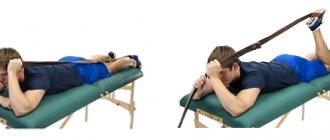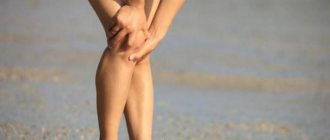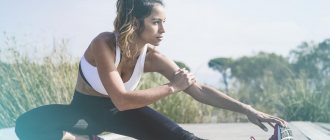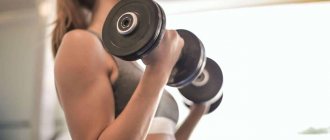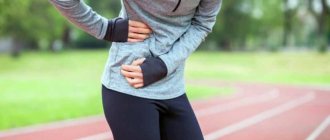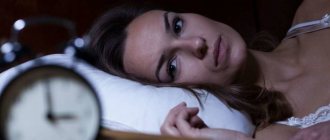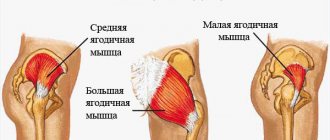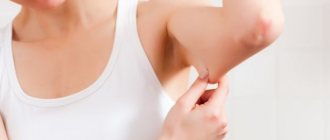The knee joint is one of the most complex joints in the human body. It is subjected to the greatest load, so discomfort often occurs in it. You can often hear the question: why do my knees hurt when squatting? There can be many reasons for this. Knee pain is most often caused by injury, although other factors may also play a role. Sometimes the inability to even squat indicates a serious illness.
A little about the knee
The knee joint is a joint that connects the patella, femur and tibia (roughly speaking, thigh, tibia and kneecap). It consists of cartilages, menixes, collateral ligaments, etc. The structure is really very complex.
This entire “mechanism” is placed in an articular capsule (also called a joint capsule), inside which a special fluid is produced. This fluid nourishes and moisturizes the joint, minimizes friction and protects the entire cartilage complex from mechanical damage.
If any of the above fails, a person will have difficulty squatting, let alone doing squats in the gym.
Treatment
Once a diagnosis has been made, and the pain in the knee area is the result of an illness or serious injury, there is no way to get by with general measures. How to treat knees if they hurt when squatting and standing up? In addition to the main treatment prescribed by a specialized specialist, he can recommend the following auxiliary measures to the patient:
- If an injury is detected, the knee joint should not be strained. All sports and any intense movements are prohibited. This is necessary to prevent consequences and complications.
- If arthritis has been diagnosed, non-steroidal drugs are prescribed as an analgesic and anti-inflammatory drug.
- If you have gout, it is recommended to review your diet and exclude from it those foods that have a fairly high content of purine bases.
- In the absence of deformations and degradation of cartilage tissue, as well as neoplasms in the joint area, exercise therapy is recommended.
All of these measures cannot be prescribed independently, since some of the measures aimed at improving the condition may have the opposite effect.
Important! After performing physical therapy exercises, rest is required. In the event that pain occurs in the affected area when performing an exercise, you should abandon it completely.
Why do my knees hurt when squatting?
Problems can arise due to meniscus injury, inflammation, cartilage damage, lack of joint (synovial) fluid, etc. Below we will look at the main causes of pain.
Initial manifestations of arthrosis
Arthrosis is a complex name for diseases associated with joint damage. The concepts of arthrosis and arthritis are often confused due to almost identical symptoms. For general development, let’s make a distinction: arthritis involves an inflammatory process throughout the body, and arthrosis refers directly to the composition.
Symptoms of arthrosis:
- Knees crunch when squatting. Don't get confused! Every person sometimes has a crunch in their joints, but with arthrosis it is rough and dry. It is difficult to confuse it with ordinary clicking.
- Decreased mobility in the knee. If you used to be able to sit with your legs tucked under you, but now you can’t, that’s not good.
- Deformation. Rarely appears in the initial stages, unless the cause is a knee injury.
- Pain when bending. It can appear before and after squats. It can be: aching, sharp, sharp, persistent, etc. In the initial stages, it does not occur at rest.
Note! There's an easy way to find out if you should be concerned about creaking knees: try cracking your fingers. No seriously. If the sound your knees make is similar to the crunching of your fingers, there is no need to panic (if this is the only symptom, of course).
Causes of teenage arthrosis
Arthrosis is getting younger and is difficult to diagnose. It can begin to form in adolescence, but young guys do not attach importance to the occasional tingling sensation. As a result, the disease is diagnosed by the age of 20 in a progressive stage. Why is this happening?
A teenager’s knee joints are not ready for serious physical activity. The muscles may be ready, but the joints are not. There is also no indicator, no “litmus test” that would tell a teenager that it’s time to slow down. The disease can develop without pain.
Note! Younger people are also more likely to start training without warming up, neglecting safety precautions.
Flat feet and knee deformity
People who have flat feet are 31% more likely to develop osteoarthritis. It is not known how closely this fact is related to physical activity, but severe flat feet are a 100% contraindication to barbell squats. The defect simply makes the exercise technically incorrect. This can lead to increased stress on the knee joint. Replace the exercise with a leg press.
Knee sprain
Sprains are a common injury during sports. Did you make a sudden awkward movement? Did you take on too much weight? Started training without warming up? Keep the sprain.
There are 3 degrees of sprain severity:
- I-degree – accompanied by acute pain, which goes away on its own within 1-3 weeks maximum. She won't bother you anymore, but you still need to get checked.
- II-degree - the tissue structure is severely damaged, the joint can no longer maintain its integrity. Medical intervention is required.
- III – degree – torn ligaments. The pain is so severe that the person goes into shock. Previously, such an injury meant the exclusion of any physical activity. Now you can correct the situation surgically.
Knee dislocation
Another cause of pain when bending. In the first minutes after an injury, many people confuse a knee dislocation with a severe sprain. The symptoms are similar: sharp pain, impaired mobility, swelling, etc. It is easy to distinguish one from the other. With dislocation, deformation is almost always visually noticeable; with stretching, this effect is absent.
Note! If a sprain can be avoided without medical intervention, a dislocation necessarily requires calling an ambulance.
Menix damage
The last cause of pain that we will look at today is damage to the menix. It can be diagnosed in older people (40-50 years old) or occur due to injury. For example, a menix rupture is detected in more than half of the fractures.
The damage is accompanied by an increase in temperature in the joint (the area “burns”), pain, clicking when bending, and an increase in the volume of the knee joint.
Diagnostics
If you feel discomfort while performing an activity related to squatting, the right decision would be to consult a doctor. If soreness is a manifestation of pathology, early detection significantly increases the chances of full recovery.
The traditional set of diagnostic measures includes:
- X-rays of the knee joint provide information about destructive processes that affect bone tissue.
- Magnetic resonance therapy allows you to study in detail the condition of the connective tissue; this method reveals cartilage dystrophy at the initial stage, when the bones have not yet undergone deformation.
- Ultrasound of the knee joint is a popular examination method that allows you to fully assess the condition of the joint.
- Arthroscopy is an invasive method of examining the inner wall of the joint capsule, allowing not only diagnostic but also therapeutic measures.
- Puncture - carried out for the purpose of collecting effusion for bacteriological examination.
- Analysis of the composition of blood and urine, carried out in laboratory conditions to assess ESR; an increase in this indicator indicates the process of inflammation.
What to do if you have knee pain?
You need to try to determine the cause of the pain. Until it is installed, any physical activity should be avoided. If the cause is a slight sprain or minor bruise, you can limit yourself to self-medication and reducing the load. For “causeless” pain, self-medication is not recommended.
How is the diagnosis done?
Decide on the nature of the pain before going to the doctor. Above we have already described the characteristic symptoms of diseases of the knee joint. Check your body for their presence. The doctor will definitely ask about this before the examination.
To accurately determine the diagnosis and prescribe treatment, the doctor first palpates your knee. Later he sends the patient for instrumental and laboratory diagnostics. They do to you:
- X-ray.
- Ultrasound.
- Biochemical and general blood test.
- Collection and analysis of joint fluid.
- MRI of the knee joint.
In most cases, the diagnosis is reliably known after MRI.
First aid for dislocations, bruises and sprains
First aid for bruises, dislocations and sprains is different. If you are injured, proceed as follows:
- Apply a cold compress to the damaged area for 15-20 minutes.
- Apply the bandage tightly enough to prevent bleeding. Place the cold on top of the bandage again and leave it there for one and a half to two hours. Be careful not to overfreeze the area.
- After a few hours, take a warm bath to speed up the resorption of the spilled blood.
When stretched:
- Apply a cold compress and apply a bandage (or an elastic bandage).
- Do not load the ligament for two days. It is advisable to stay in bed at all.
- To prevent this from happening again, do therapeutic exercises and practice self-massage.
Note! If you suspect a rupture, the pain does not go away, and severe swelling is noticeable in the joint, contact a traumatologist.
In case of dislocation:
- Call an ambulance.
- In any available way, fix the knee in the position it took after the injury, cool the area.
- Take a horizontal position, place the fixed leg so that it is higher than the rest of the body. This can only be done with outside help. If there is no one nearby, just don't move.
Note! It’s unlikely that such an idea will come to your mind, but we’ll still warn you: don’t eat or drink anything. It is quite possible that you will have surgery right away at the hospital. To do this, you will need to do a rapid blood test and local anesthesia.
Diagnosis
If a specialized specialist complains of pain in the knee joint during flexion and extension, he conducts an initial examination of the patient. The initial examination includes the following procedures:
- patient interview;
- viewing a medical record;
- visual inspection;
- palpation;
- issuing referrals for tests and research.
As part of a diagnostic examination, the patient is required to follow the doctor’s instructions - tests and studies guarantee the truth of the diagnosis and the correctness of treatment tactics. As usual, the list of necessary diagnostic measures is as follows:
- blood analysis;
- Analysis of urine;
- X-ray examination;
- MRI;
- CT;
- Ultrasound;
- arthroscopy of the knee joint.
The last type of study is invasive and is prescribed exclusively when other methods are powerless or there is suspicion of a serious pathology of the knee joint.
How to treat knee pain?
Knee joint diseases are an age-related problem. It is present in 30% of people aged 50-60 years. Athletes (especially runners, football players and bodybuilders) develop the disease earlier. Are you at risk? Read how to prevent the disease and cure it.
Proper nutrition to prevent joint disease
How to protect yourself from injuries and arthrosis? A balanced diet, moderate physical activity and compliance with safety precautions when playing sports will help you. Let's start with nutrition:
Make sure that your diet contains vitamins C, E, B6, B5 and A. Together they will have a positive effect on cartilage tissue cells: they neutralize substances that cause cartilage destruction and promote the restoration and growth of cartilage tissue.
- Lettuce, eggs, liver (E).
- Fermented milk products, kidneys, yolk, peanuts (B5).
- Meat, fish, legumes (B6).
- Carrots, cabbage, lettuce, butter, cream (A).
- Citrus (C).
Note! You can make up for all this with vitamin supplements, but it will be more expensive and hardly effective. The body can only consume a limited amount of vitamins; everything else comes out naturally.
Physical activity and sports
Combine proper nutrition with moderate physical activity: do a warm-up every few hours if your job is sedentary. Regular walks are a great help: joint diseases are much less common among dog owners.
When playing sports, follow safety precautions. Always do a warm-up. By warming up the joint, we simultaneously increase the amount of joint fluid and reduce the risk of sprains.
Treatment at home and hospital
Remember that most “folk methods” are aimed at eliminating symptoms, not the cause of the disease. You can use a warm compress and ointment to temporarily relieve the painful sensation, but no more.
To treat the injury, the help of a surgeon may be required (for example, when reducing dislocations). Inflammatory processes can be effectively relieved with the help of a physiotherapist, massage therapist, PRP therapy and therapeutic exercises. About her below.
Therapeutic gymnastics for rehabilitation
Therapeutic exercises are prohibited from performing in acute diseases. They are needed for rehabilitation during the postoperative period and after wearing a cast. After an injury, gradual loading will help you regain mobility and get used to bending your knee again.
Before exercising, consult your traumatologist:
- Wall squats. Lean your back against the wall and slowly slide down it until you feel discomfort. Easily.
- "Step". Take the platform and stand on it with one foot or the other. Like fitness, but much slower and without rhythmic music.
- Flexion on the stomach. Lie on your stomach and alternately bend your knees, lifting your shins up. Exactly! It's like you're a dreamy girl lying on the bed in front of a magazine.
Therapeutic measures
Therapy for an unpleasant symptom, such as pain in the knees when squatting, consists of an integrated approach to this problem. After making a diagnosis, the doctor makes a decision on methods of pain relief. First of all, drug therapy is prescribed, which is conventionally divided into symptomatic and specific, depending on the disease.
After the acute pain reaction has been relieved, during the period of remission, physiotherapeutic procedures are carried out to restore blood flow, normalize metabolic reactions, and accelerate tissue regeneration. To consolidate the therapeutic effect, a course of massage and physical therapy exercises are prescribed to restore the maximum range of motion in the knee joint.
Drug therapy
- Non-narcotic analgesics for relieving moderate pain - Analgin, Baralgin, Tempalgin.
- Local blockades with Novocaine, Lidocaine for severe pain attacks.
- Non-steroidal anti-inflammatory drugs for the relief of pain and inflammation - Ketoprofen, Flurbiprofen, Piroxicam.
- If NSAIDs are ineffective, the doctor prescribes glucocorticosteroids - Prednisolone, Hydrocortisone.
- The presence of degeneration requires long-term use of chondroprotectors - Honda, Dona, Teraflex.
- Immunosuppressants in the presence of rheumatoid factor - Methotrexate, Cytosar, Krasnitin.
- For a gout attack, Colchicine is prescribed, which is taken in the first hours of severe pain. The drug has side effects that have a depressing effect on the gastrointestinal tract. If an undesirable effect occurs, Colchicine is replaced with Indomethacin.
- Antibiotic therapy in the presence of an infectious pathogen - Ampicillin, Azithromycin.
Physiotherapy
If knee pain occurs, a course of physiotherapeutic treatment is prescribed to restore the knee joint and strengthen the general condition. Drug electrophoresis is the only method that can be used for pain. Lidocaine can be used as a medicinal base for pain relief, and Hydrocortisone to eliminate inflammation.
Magnetic therapy is carried out in courses. Sessions have a cumulative therapeutic effect, which is achieved by the end of the procedures. The therapeutic effect is achieved by a pulsed electromagnetic field. Laser therapy and ultrasound help improve hemodynamics and initiate tissue self-renewal processes at the cellular level.
Massage and gymnastic exercises
During the period of acute onset of pain, massage is not performed. The procedure is prescribed during a painless period; in the future, it is recommended to carry out preventive sessions 2 times a year. With the correct technique for performing therapeutic massage, the knee becomes more mobile and the condition of the surrounding muscle fibers improves.
To fully restore motor function, strengthen muscles and ligaments, a set of exercises is compiled according to the functional state of a particular patient. The first classes are conducted in a medical facility in the presence of an instructor. This measure is necessary for teaching the technique of movements and dosing the load, exceeding which can negate the treatment done. With regular exercise, a good restorative effect is ensured.
How to exercise when you have pain?
No way. No responsible trainer will let you into the gym if you complain of sudden sharp pain when doing squats. With injuries, the situation is a little simpler.
If the pain is caused by a minor bruise or injury, modify your workout to rest the knee joint for a while. Eliminate squats, reduce the load. How to replace exercises? Do seated dumbbell presses, pump up your upper abs, etc.
Note! Do this only if you cannot imagine a day without training. In a good way, any physical activity after an injury is excluded.
What to do before going to the doctor
If you notice that your knees are crunchy and you feel pain after squatting, consult a doctor immediately. However, it is not always possible to do this right away. Before visiting the doctor, try to help yourself.
First of all, the joint should be provided with complete rest. If this cannot be done, then it is advisable to fix the joint with an elastic bandage. Its task is to stabilize the joint as much as possible and reduce the load on it. If the patient plays sports, then training will have to be postponed. To relieve pain, you can use the following:
- warm compresses;
- anesthetic ointments or other local remedies - Diclofenac, Indomethacin;
- folk remedies - ointment on birch buds, egg ammonia.
If your knees creak after squatting, this may indicate serious damage to the joint. Self-medication in this case can be very expensive in the future.
Proper barbell squat technique
The barbell squat is the most dangerous exercise for your knees. Efficiency and safety depend entirely on your technique. Here is a diagram of a classic squat:
- Take a weight of 40% of the maximum if you are a beginner. The maximum weight is the weight you can lift in one workout.
- Grab the barbell so that your grip is slightly wider than shoulder-width apart. You can squat with a barbell on your shoulders and on your back. Please note! Back squats put a lot of stress on the knees.
- Do full or partial squats. Deep squats are not as dangerous as increasing weight, but they have an even greater effect.
The position of the legs should be comfortable and as stable as possible. Most people find a shoulder-width position suitable. Make sure your head continues the line of your spine.
Note! If you are under 18 years of age, do not perform barbell squats without a knee stabilizer and the support of a professional trainer. If you are overweight, it is better to limit strength training.
Preventive measures and prophylaxis
To prevent any damage to the joints of the lower extremities, as well as to reduce the likelihood of inflammation, common sense should be used. This is required not only in everyday life, but also when playing sports. If you have non-recurrent pain, you can try to get rid of it by following these instructions:
- Before any physical exercise, a warm-up is required.
- After performing exercises, your knees need rest and relaxation.
- When performing squats, the technique of their execution must be ideal.
- If pain occurs, you need to reduce the intensity of the exercise - this will prevent injury and deformation of the joint.
- Avoid hypothermia of joints.
- Treat all diseases in a timely manner.
- Eat a balanced diet and keep your weight under control.
Such measures will help to avoid unwanted processes in the joints in youth and reduce their likelihood in old age.
When is pain normal?
Unpleasant sensations during physical activity, including pain in the knee when squatting, are a common occurrence. It may appear due to certain changes in the muscle-tendon complexes and osteo-articular elements of the knee area. Sometimes discomfort is a normal phenomenon that has completely objective reasons . It is worth talking about this in the following cases:
- Weak and short-lived soreness of certain muscles of the thigh and lower leg or an entire group. Most often, this is a natural phenomenon during exercise, which is due to the fact that lactic acid accumulates in the tissues. The duration and likelihood of such pain occurring depends on how trained the muscles are. The more prepared they are for stress, the less muscle pain they will experience.
- Short-term aching pain, the localization of which cannot be completely determined, in the knee area. After training, athletes may feel slight compression of the entire composition; there will not be one painful point.
Knee pain after squats, if it is normal, will be mild and short-lived. After resting for a certain time, the unpleasant sensations weaken or disappear altogether. If the muscles are not prepared, they will always hurt after physical activity.
